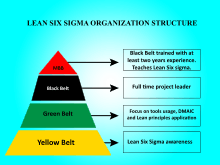Lean Six Sigma
Lean Six Sigma is a methodology that relies on a collaborative team effort to improve performance by systematically removing waste [1] and reducing variation. It combines lean manufacturing/lean enterprise and Six Sigma to eliminate the eight kinds of waste (muda):
- Defects
- Over-Production
- Waiting
- Non-Utilized Talent
- Transportation
- Inventory
- Motion
- Extra-Processing
Lean six sigma not only reduces process defects and waste, but also provides a framework for overall organizational culture change.[2]

Waste
Waste is defined by Mr. Fujio Cho of Toyota as “Anything other than the minimum amount of equipment, materials, parts, space, and workers time, which are absolutely essential to add value to the product.”[3]
As mentioned above, there are eight different types of waste. Each one is defined below:
Over production is excess amount of product that is produced. Idle time waste, or wait time waste, is down time that is spent waiting for a product to be created. The delivery waste, or transportation waste, is the time spent getting the product shipped to the recipient. Waste in the work, inventory, and operations is time spent loosely and does not make money. Waste in the work is also known as extra-processing waste, and waste in operations is also known as motion waste. Rejected parts waste, or defects waste, is when certain pieces should be thrown out or reworked because they are not within tolerance. Lastly, we have non-utilized talent waste which is when a person that is untrained for a position is put there to try and complete work.[4]
History
1980s-2000s
What was today to become Lean Six Sigma can be traced to Motorola in the United States in 1986 to compete with the Kaizen business model in Japan. In the 1990s Allied Signal hired Larry Bossidy and introduced Six Sigma in heavy manufacturing. General Electric's Jack Welch consulted Bossidy and began Six Sigma at General Electric.
During the 2000s Lean Six Sigma forked from Six Sigma.
2000s-2010s
The first concept of Lean Six Sigma was created in 2001 by a book titled Leaning into Six Sigma: The Path to integration of Lean Enterprise and Six Sigma by Barbara Wheat, Chuck Mills, Mike Carnell.[5]
In the early 2000s Six Sigma principles expanded into other sectors of the economy, such as Healthcare, Finance, Supply Chain, etc.
Description
Lean Six Sigma is a synergized managerial concept of Lean and Six Sigma. Lean traditionally focuses on the elimination of the eight kinds of waste/muda classified as defects, over-production, waiting, non-utilized talent, transportation, inventory, motion and extra-processing. Six Sigma seeks to improve the quality of process outputs by identifying and removing the causes of defects (errors) and minimizing variability in (manufacturing and business) processes. Synergistically, Lean aims to achieve continuous flow by tightening the linkages between process steps while Six Sigma focuses on reducing process variation (in all its forms) for the process steps thereby enabling a tightening of those linkages. In short, Lean exposes sources of process variation and Six Sigma aims to reduce that variation enabling a virtuous cycle of iterative improvements towards the goal of continuous flow.
Lean Six Sigma uses the DMAIC phases similar to that of Six Sigma. Lean Six Sigma projects comprise aspects of Lean's waste elimination and the Six Sigma focus on reducing defects, based on critical to quality characteristics. The DMAIC toolkit of Lean Six Sigma comprises all the Lean and Six Sigma tools. The training for Lean Six Sigma is provided through the belt based training system similar to that of Six Sigma. The belt personnel are designated as white belts, yellow belts, green belts, black belts and master black belts, similar to judo.

For each of these belt levels skill sets are available that describe which of the overall Lean Six Sigma tools are expected to be part at a certain Belt level. These skill sets provide a detailed description of the learning elements that a participant will have acquired after completing a training program. The level upon which these learning elements may be applied is also described. The skill sets reflect elements from Six Sigma, Lean and other process improvement methods like the theory of constraints (TOC) total productive maintenance (TPM).
How Lean and Six Sigma come together
Lean six sigma organizes lean and six sigma to cut production costs, improve quality, speed up, stay competitive, and save money. From six sigma they gain the reduced variation on parts. Also, lean focuses on saving money for the company by focusing on the types of waste and how to reduce the waste. The two coming into lean six sigma to better each other creating a well balanced and organized solution to save money and produce better parts consistently.[4]
Tools for lean and six sigma
Lean: Kaizen, Value Stream Process Mapping, 5s, Kanban, Error Proofing, Productive Maintenance, Set Up Time Reduction, Reduce Lot Sizes, Line Balancing, Schedule Leveling, Standardized work, and Visual Management.[4]
Six Sigma: Recognize, Define, Measure, Analyze, Improve, Control, Standardize, and Integrate.[4]
5S
5S is a lean practice used to keep production workspace orderly and keep the workforce committed to maintaining order.
| 5S (Japanese) | 5S (English) | Definition |
|---|---|---|
| Seiri | Separate or Sort | Separating needed tools, parts, and instructions from unnecessary items[6] |
| Seiton | Straighten | Setting things in order, creating optimal boundaries, and locations for each item in a work area[7] |
| Seiso | Shine | Cleanliness of the work space after each day to maintain order[8] |
| Seiketsu | Standardize | Reminds people to conduct Seiri, Seiton, and Seiso to maintain the work place and pristine condition[9] |
| Shitsuke | Sustain | Ensuring that the organization has the discipline to sustain the habitat of sorting, organizing, and cleaning.[9] |
See also
References
Citations
- ↑ ""Xerox cuts popular lean six sigma program"". democratandchronicle. Retrieved March 10, 2015.
- ↑ Summers 2011, p. 9.
- ↑ Summers 2011, p. 135.
- 1 2 3 4 Summers 2011.
- ↑ Leaning into Six Sigma: The path to integration of Lean Enterprise and Six Sigma. Boulder City, Colorado. 2001. ISBN 978-0971249103.
- ↑ Summers 2011, p. 125.
- ↑ Summers 2011, p. 126.
- ↑ Summers 2011, p. 128.
- 1 2 Summers 2011, p. 129.
Bibliography
- George, Michael L. (2002). Lean Six Sigma: Combining Six Sigma Quality with Lean Production Speed (1st ed.). McGraw-Hill Education. ISBN 978-0071385213.
- George, Michael L.; Rowlands, David; Kastle, Bill (2003). What is Lean Six Sigma?. McGraw-Hill Education. ISBN 978-0071426688.
- George, Michael L. (2004). The Lean Six Sigma Pocket Toolbook: A Quick Reference Guide to 100 Tools for Improving Quality and Speed (1st ed.). McGraw-Hill Education. ISBN 978-0071441193.
- Kowansky, Elaine; Friberg, Norm (2006). How NOT To Implement Six Sigma: A manager's guide to ensuring the failure of the world's greatest Quality Improvement and Waste Reducing Machine. Xilbris. ISBN 978-1425712266.
- Bass, Issa; Lawton, Barbara (2009). Lean Six Sigma Using SigmaXL and Minitab. McGraw-Hill Education. ISBN 978-0071621304.
- Pyzdek, Thomas; Keller, Paul (2014). The Six Sigma Handbook, Fourth Edition (4th ed.). McGraw-Hill Education (published May 13, 2014). ISBN 978-0071840538.
- Morgan, John; Brenig-Jones, Martin (2015). Lean Six Sigma for Dummies, Third Revised Edition (3rd ed.). John Wiley & Sons (published Nov 6, 2015). ISBN 978-1119067351.
- Summers, Donna C.S (2011). Lean Six Sigma: Process Improvement Tools and Techniques. One Lake St, Upper Saddle River, New Jersey: Prentice Hall. ISBN 978-0-13-512510-6.
External links
- Lean Six Sigma for Real Business Results, IBM Redguide